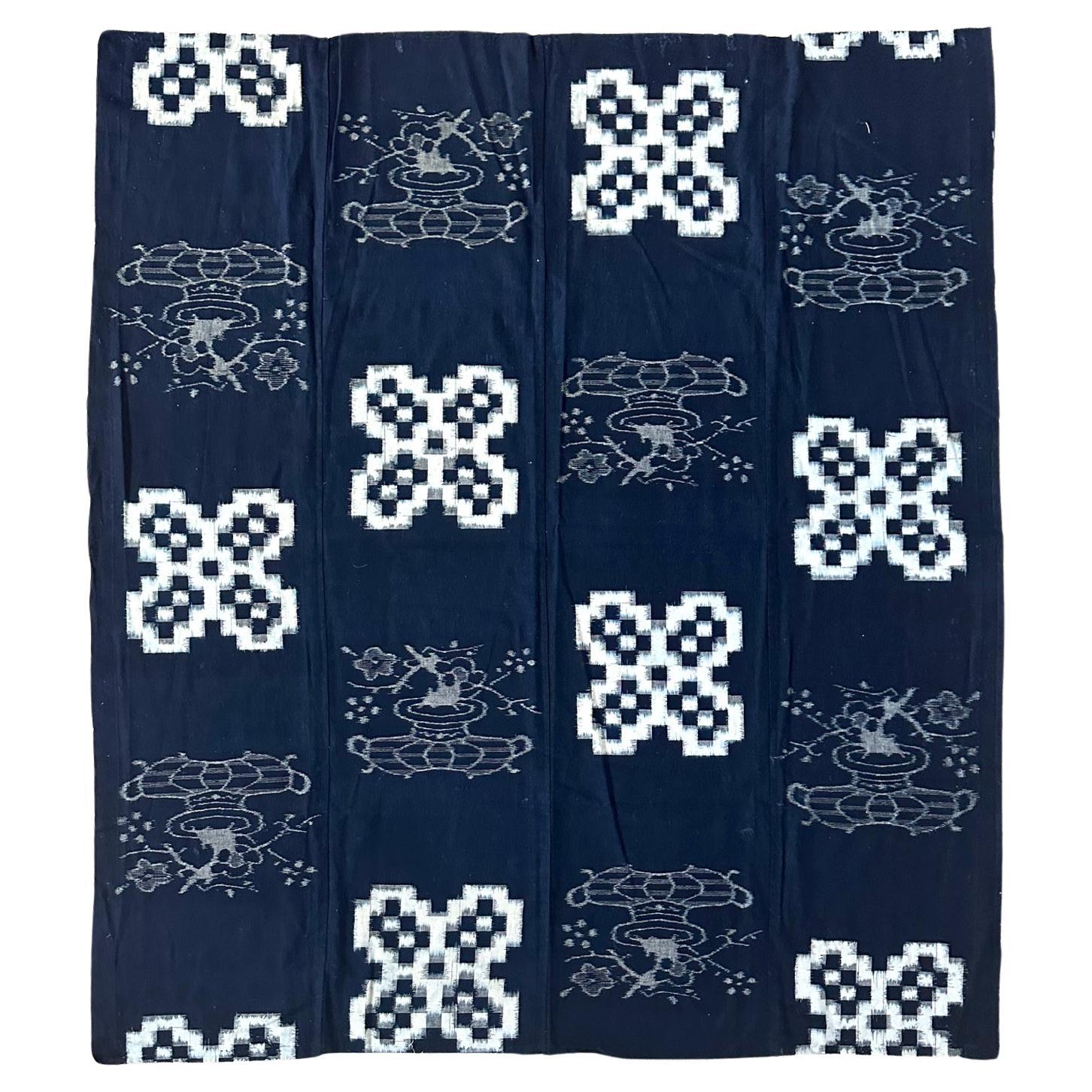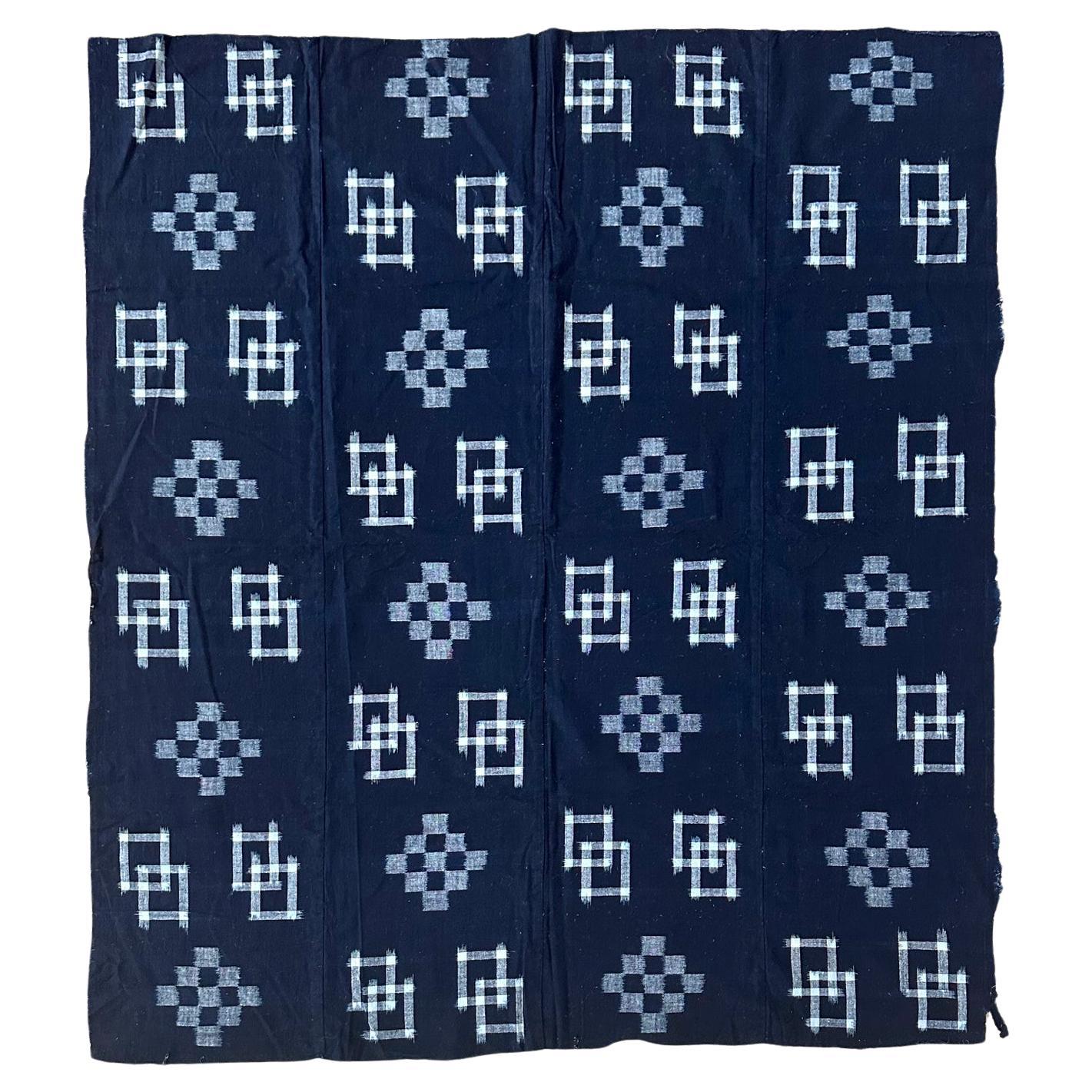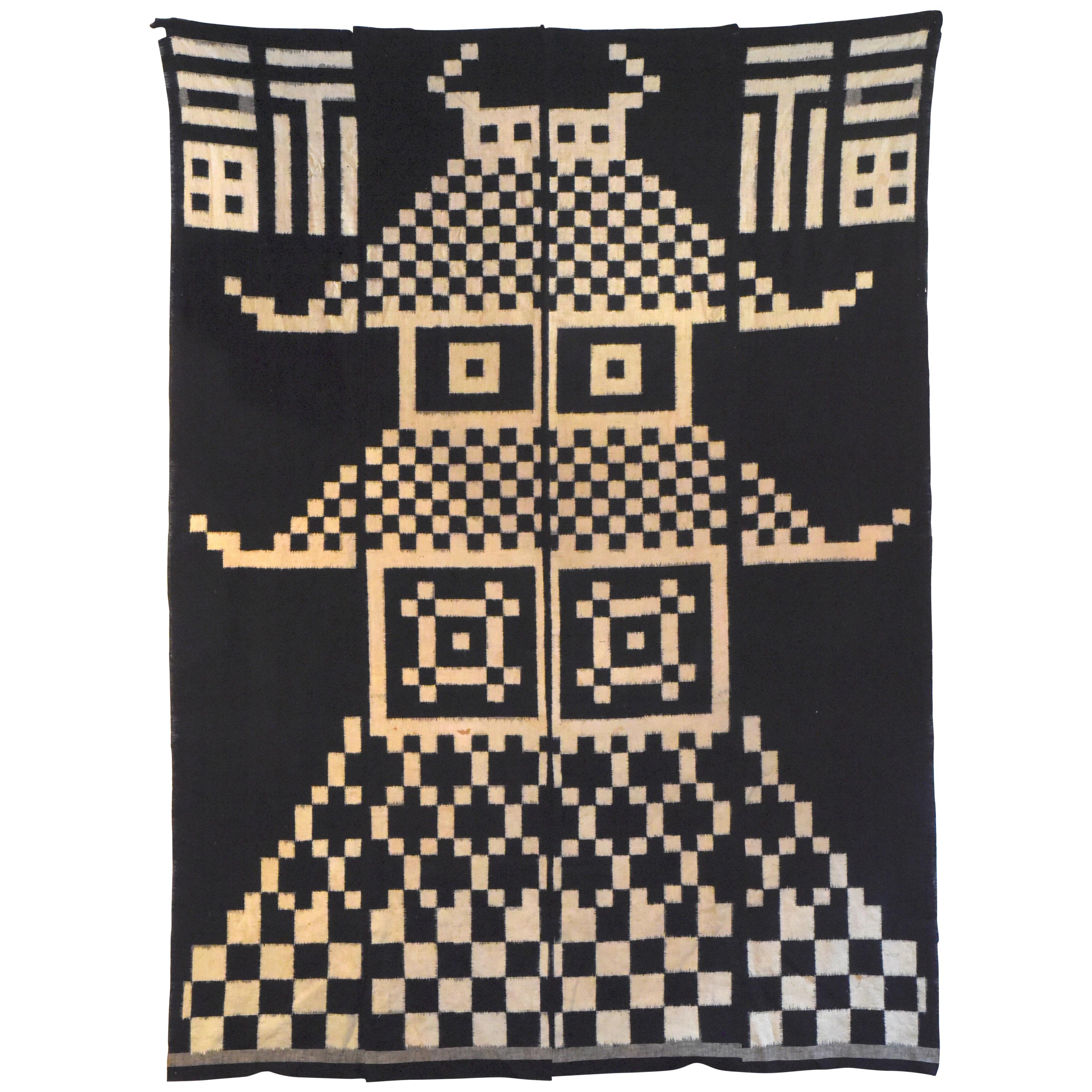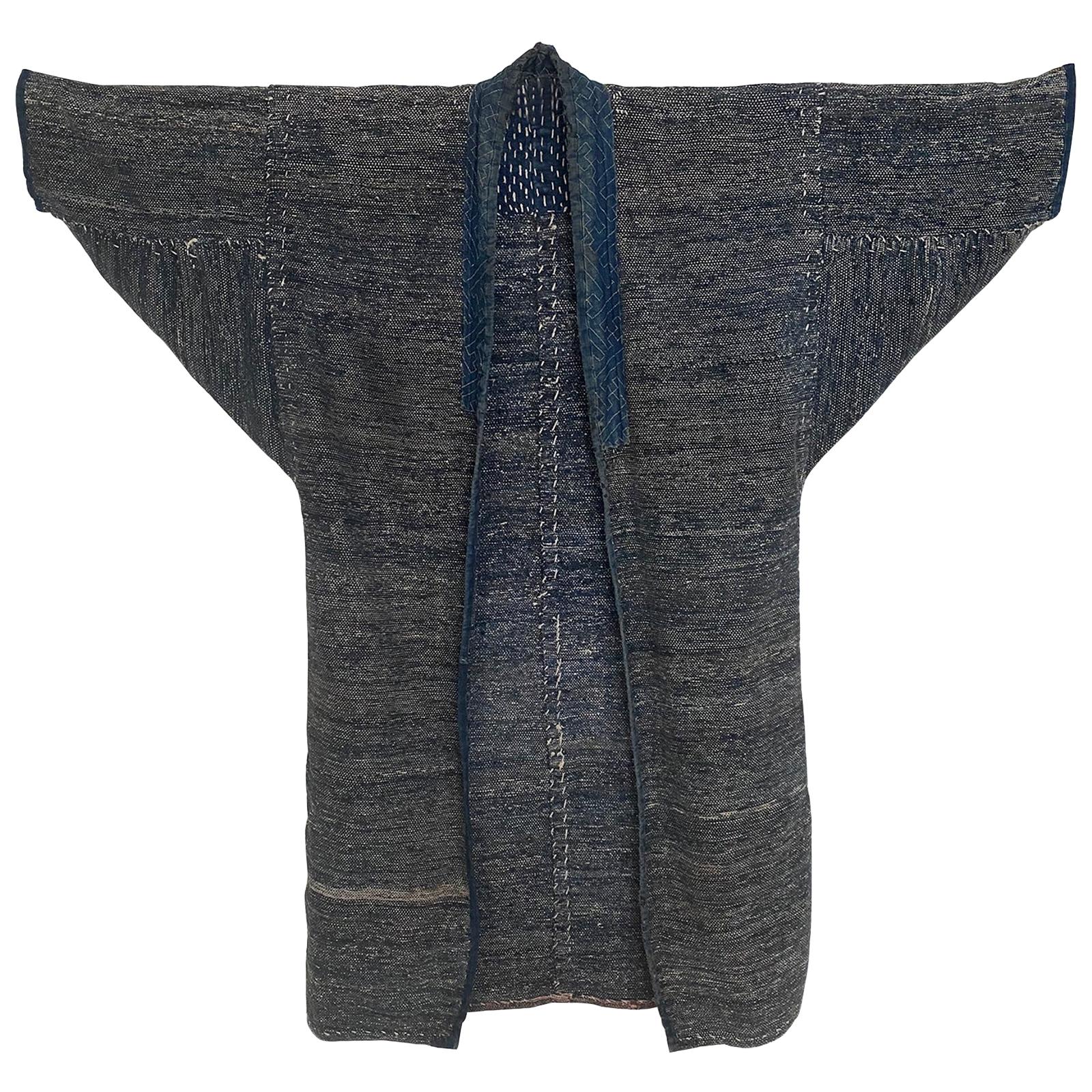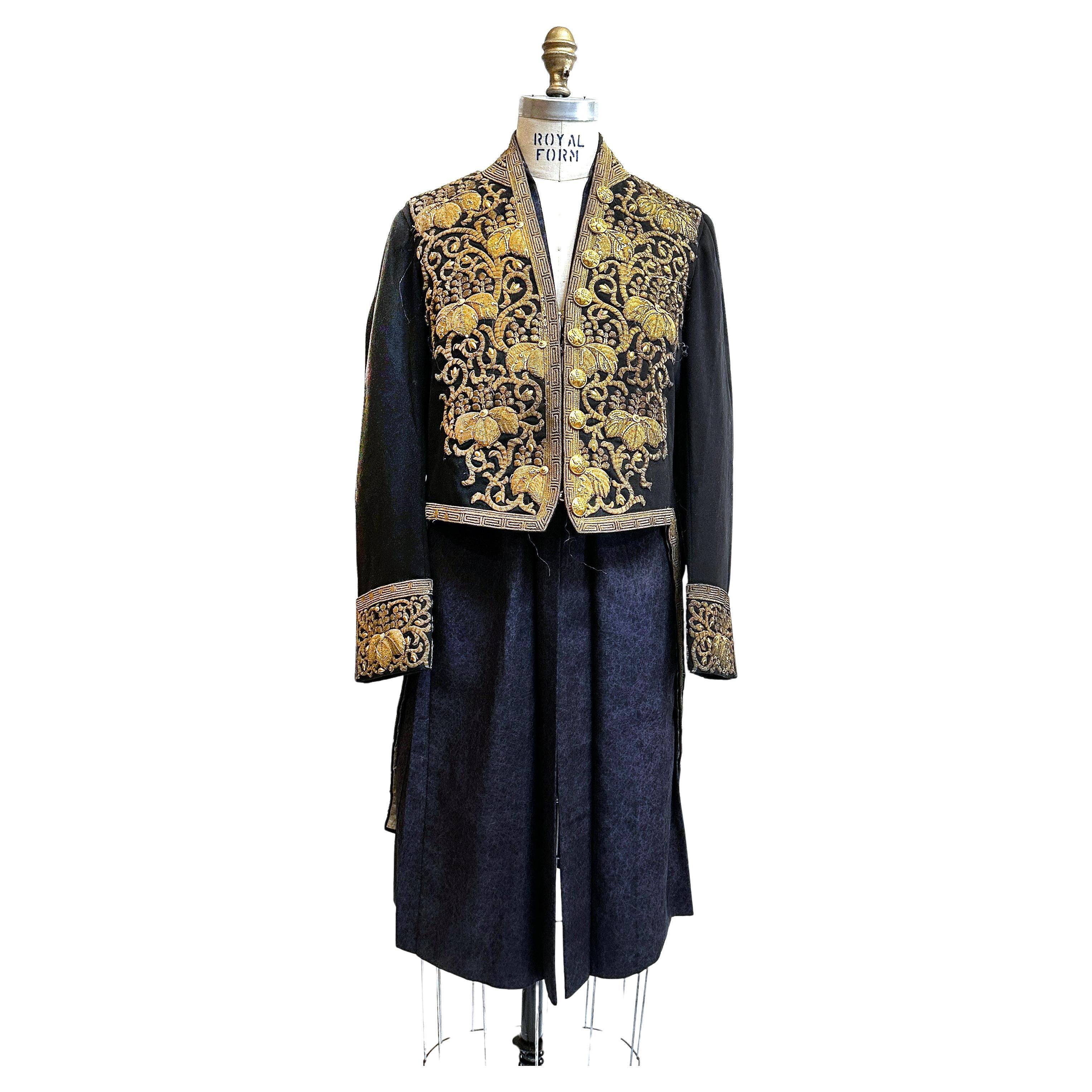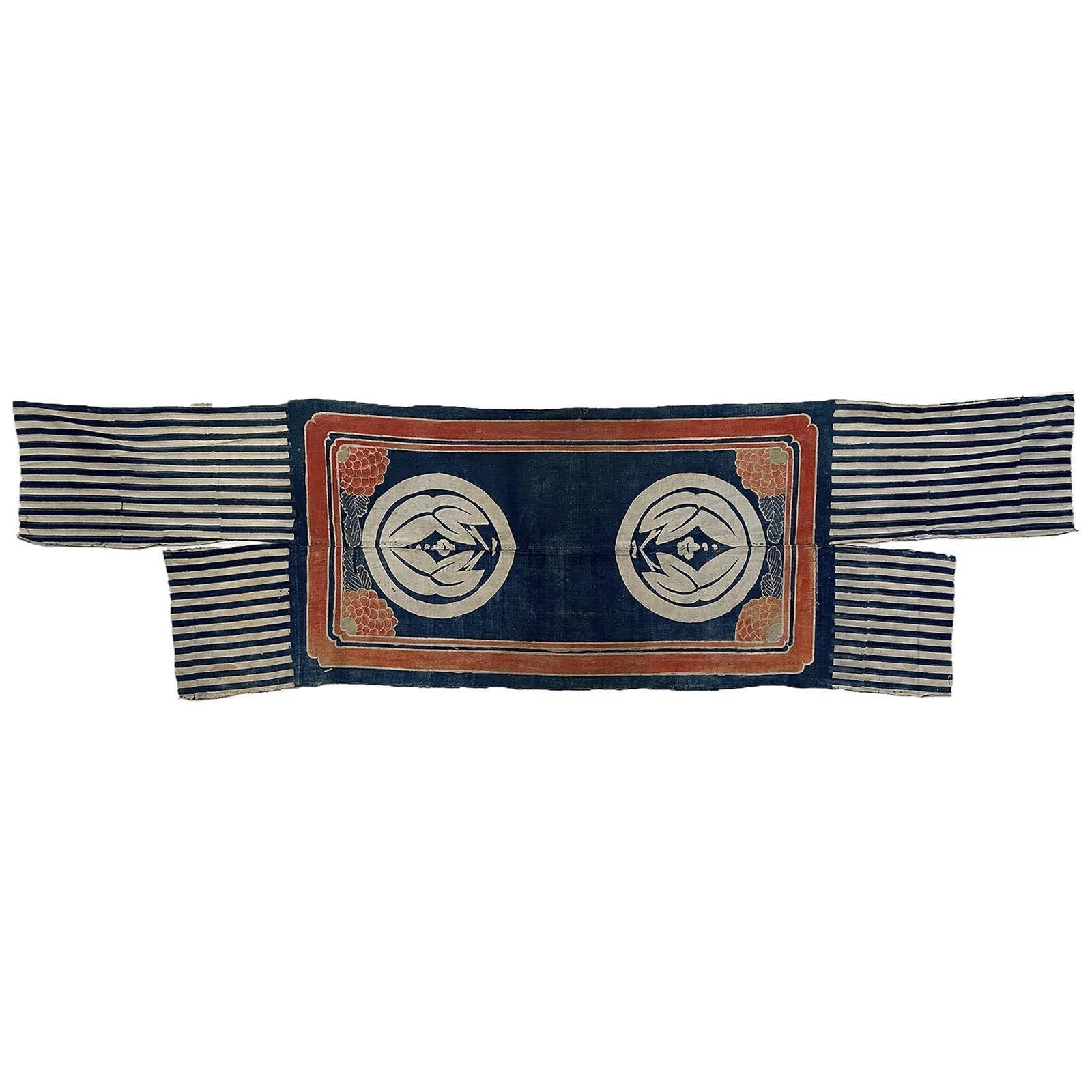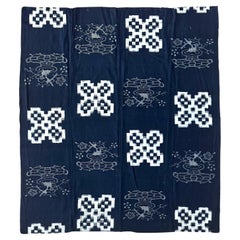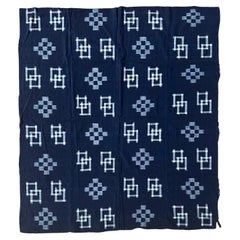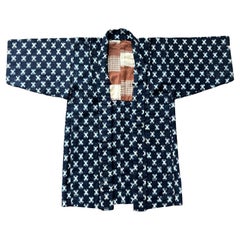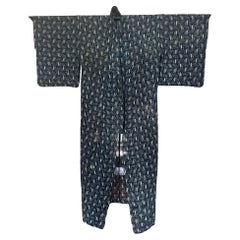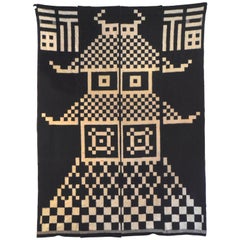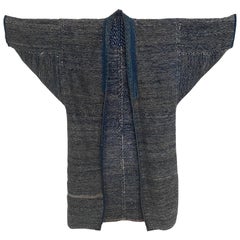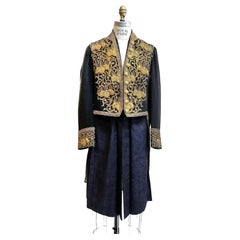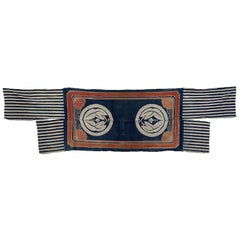Items Similar to Japanese Indigo Kasuri Ikat Traveling Cape
Want more images or videos?
Request additional images or videos from the seller
1 of 18
Japanese Indigo Kasuri Ikat Traveling Cape
About the Item
Known in Japanese as Bozugappa (priest's raincoat), this cape-like garment was worn by the travelers in Japan circa late 19th century to early 20th century (end of Meiji period). Derived from the cape worn by the Portuguese missionary, who first arrived in Japan in mid-16th century, this type of cape was originally reserved for the Japanese military members, until it was adopted by the general public in the 18th century. Essentially a simple semi-circular form, the outer layer was a patchwork of long stripes of clothes in a slightly radiation pattern. It was lined inside with another layer of woven cotton fabric. Sometimes, layers of paper were sandwiched in between to keep it water and cold-resistant.
The cape on offer is of fine condition and appears to be in its original state. The outer layer was made from an indigo dyed linen (likely Ramie fiber) woven with weft e-kasuri (picture ikat) that depicts patterns of Bagua (hakka in Japanese), butterfly shapes and dotted circle. The inner lining was a woven linen in blue and white in grid pattern. The cotton trims were hand-sewn all around the edges to enforce the strength of the cape. Based on the material, the cape was likely used in the warmer seasons. It was meant to wrap around the body overlapping at the front and fasted around the neck. There were four tassels with small piece of rectangular bone as button attached with space around the neckline for easy adjustment.
As displayed spread out, it measures 3'5'' x 5'0'' (104 x 152 cm).
To compared with two similar examples, see 2019.20.119 and 2019.20.76 in the collection of Minneapolis Institute of Art (MIA).
2019.20.76 is also Illustrated in "Textile of Japan" Prestel, page 280.
- Dimensions:Height: 41 in (104.14 cm)Width: 60 in (152.4 cm)Depth: 1 in (2.54 cm)
- Style:Meiji (Of the Period)
- Materials and Techniques:
- Place of Origin:
- Period:
- Date of Manufacture:Late 19th to Early 20th Century
- Condition:Wear consistent with age and use. Fine condition with a couple small staining on the lower trims. Small thread losses to one of the attaching pad of the tassel button on the neck as shown.
- Seller Location:Atlanta, GA
- Reference Number:1stDibs: LU945030767622
About the Seller
4.9
Platinum Seller
Premium sellers with a 4.7+ rating and 24-hour response times
Established in 2006
1stDibs seller since 2010
542 sales on 1stDibs
Typical response time: <1 hour
- ShippingRetrieving quote...Shipping from: Atlanta, GA
- Return Policy
Authenticity Guarantee
In the unlikely event there’s an issue with an item’s authenticity, contact us within 1 year for a full refund. DetailsMoney-Back Guarantee
If your item is not as described, is damaged in transit, or does not arrive, contact us within 7 days for a full refund. Details24-Hour Cancellation
You have a 24-hour grace period in which to reconsider your purchase, with no questions asked.Vetted Professional Sellers
Our world-class sellers must adhere to strict standards for service and quality, maintaining the integrity of our listings.Price-Match Guarantee
If you find that a seller listed the same item for a lower price elsewhere, we’ll match it.Trusted Global Delivery
Our best-in-class carrier network provides specialized shipping options worldwide, including custom delivery.More From This Seller
View AllJapanese Textile Panel Double Ikat Kasuri Futon Cover
Located in Atlanta, GA
A Japanese woven cotton textile panel with white pattern on indigo background circa 1900-20s (end of Meiji to Tasho period). The panel was joined by four vertical stripes and was tra...
Category
Early 20th Century Japanese Meiji Textiles
Materials
Cotton
Japanese Textile Panel Double Ikat Kasuri Futon Cover
Located in Atlanta, GA
A Japanese woven cotton textile panel with white pattern on indigo background circa 1900-20s (end of Meiji to Tasho period). The panel was joined by four vertical stripes and was tra...
Category
Early 20th Century Japanese Meiji Textiles
Materials
Cotton
Rare Japanese Woven Ikat Child Kimono Nemaki
Located in Atlanta, GA
A rare and well preserved Japanese woven child's kimono circa early 20th century (end of Meiji period). The small kimono was a great example of Nemaki (...
Category
Early 20th Century Japanese Meiji Textiles
Materials
Cotton
Japanese Woven Ikat and Stenciled Summer Usumono Kimono Meiji Period
Located in Atlanta, GA
On offer is a “Natsu No Kimono” (summer kimono) also called “Usumono" (thin clothes) dated from late Meiji Period circa late 19th to early 20th century. This well-preserved garment w...
Category
Early 20th Century Japanese Meiji Textiles
Materials
Linen
Japanese Two-Piece Indigo Asa Kyogen Festival Costume Meiji Period
Located in Atlanta, GA
A two-piece Japanese festival costume based on Kyogen theater performance circa late 19th century (Meiji Period). The matching assemble consists of an oversize jacket (Suo) and a pai...
Category
Early 20th Century Japanese Meiji Textiles
Materials
Linen
Japanese Art Deco Ikat Silk Meisen Kimono
Located in Atlanta, GA
A well preserved Japanese Meisen kimono hand-sewn from woven Ikat Silk circa 1920-30s (Taisho to early Showa period). The kosode style kimono (small slee...
Category
Early 20th Century Japanese Showa Textiles
Materials
Silk
You May Also Like
Meiji Period Japanese Indigo Double Ikat Futon Cover
Located in Point Richmond, CA
Meiji period Japanese Indigo double ikat futon cover
Japanese futon cover, a double ikat pattern in four panels depicting Kumamoto Castle with im...
Category
Antique 1890s Japanese Meiji Textiles
Materials
Cotton
Saki-Ori Farmers Coat, Northern Japan, Meiji Period
Located in Point Richmond, CA
Saki-ori farmers coat, Northern Japan, Meiji period
A very heavy and substantial saki-ori coat, made of cotton with an indigo kasuri lapel. Several patches of hand sewn stitching ...
Category
20th Century Japanese Meiji Textiles
Materials
Cotton
Japanese Court Uniform for Imperial Appointee, 19th Century
Located in Point Richmond, CA
Court Uniform for Imperial Appointee, c. 1887.
Wool with gold brocade.
Court and military uniforms in emulation of European ensembles were officially adopted by the Japanese gover...
Category
Antique 19th Century Japanese Meiji Textiles
Materials
Wool, Brocade
Japanese Horse Trapping, "Uma-No-Haragake", Tsutsugaki, Cotton, Meiji Period
Located in Point Richmond, CA
Japanese horse trapping, "Uma-No-Haragake", Tsutsugaki, cotton, Meiji period
This type of haragake is called yuiage ("tied up"). The central portion covered the belly of the horse an...
Category
20th Century Japanese Meiji Textiles
Materials
Cotton
Japanese Sashiko-stitched Cotton Rodogi Work Coat, Early 20th Century
Located in Point Richmond, CA
Sashiko-stitched cotton Rodogi work coat, early 20th century, Yamagata Prefecture, Japan
A full length coat composed of indigo-dyed cotton with vertical bands of sashiko stitching w...
Category
20th Century Japanese Meiji Textiles
Materials
Cotton
$1,400 Sale Price
20% Off
Embroidered Red and Green Japanese Silk Ceremonial Kimono, 1940's
Located in Plainview, NY
An early 20th century exceptional Embroidered Japanese Ceremonial Kimono featuring marvelous handmade floral pattern in vivid colors including red, blue and green on gold. The interi...
Category
20th Century East Asian Japonisme Textiles
Materials
Brocade, Silk
$2,750 Sale Price
50% Off
Recently Viewed
View AllMore Ways To Browse
Late 19th Century To Early 20th Century
Textile Front
Japanese Linen
Portugal Textile
Japanese Butterfly
Ikat Textile
Cape Antique Furniture
Portuguese Japanese
Japanese Hand Warmer
16th Century Japanese
Antique Ikat
16th Century Textiles
Portuguese Japan
Japan Clothes
Ikat Antique Textile
18Th Century Button
Japanese Patchwork
Japanese Indigo Textile
